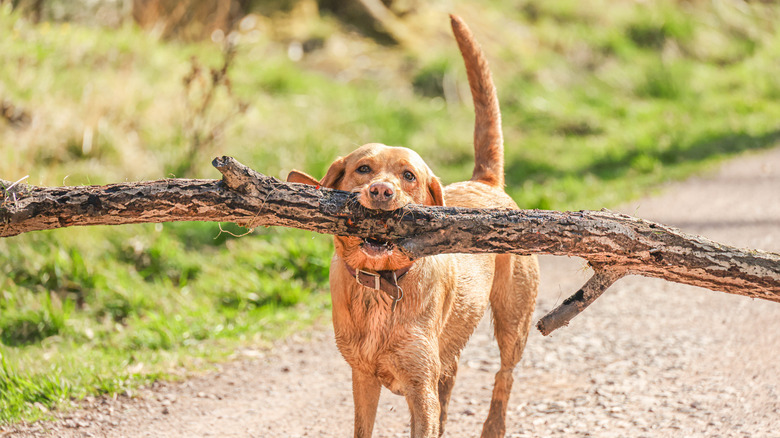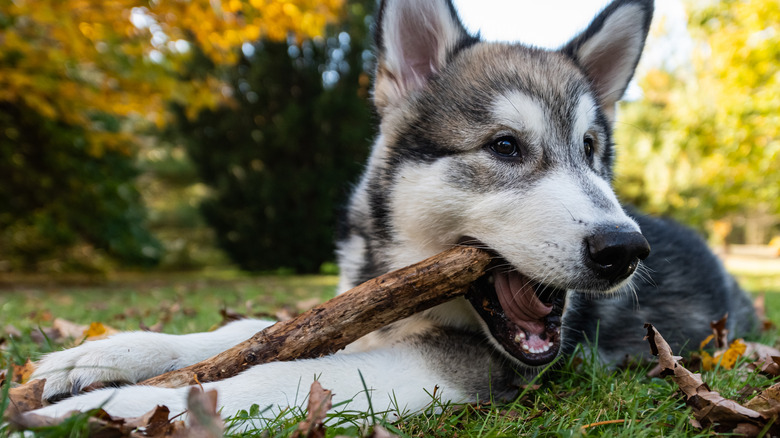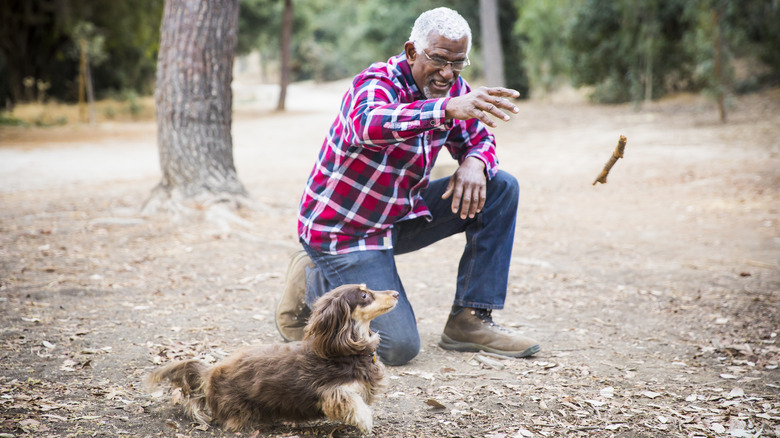Reasons Your Dog Likes Sticks So Much Explained
Dogs and fetch go together like peanut butter and jelly. Some canines love nothing more than chasing after twigs or branches and then proudly carrying their big sticks around. Others want to hunker down and chew these prizes to smithereens. But what's behind the canine penchant for pieces of wood?
First, dogs use their mouths to investigate their surroundings. In a yard, at a park, or in the woods, sticks offer numerous opportunities to experience new smells, tastes, and textures. Also, as Dr. Antoinette Martin told Southern Living (via Yahoo! Life), "Some dogs like the challenge of dragging along a big stick." Chasing and returning a stick is a natural urge for many pups, like retrievers (it's right in the name!), who were bred to help people on their hunts. Speaking of inherent urges, there is a theory that for some canines, sticks resemble bones, so they might appeal to their hunting instincts. If your dog loves showing off their stick, they could see it as a trophy of their efforts, a piece of prey they have captured.
According to Dr. Martin, another reason your dog might seem to go bonkers for branches is that you, their owner, celebrate and praise them when they play with sticks. You may expect your pup to enjoy this activity and teach them to fetch, which, in turn, could make them more interested in sticks. Dogs love it when they get positive feedback.
Is it okay for your dog to eat a stick?
While it may be safe for your pooch to fetch and carry a stick, if your dog keeps eating twigs, it's time to take them away. Pooches notoriously love chewing things — some of those objects are meant to be chomped on (dog bones, dog toys) and some are not (shoes, furniture, chicken bones, sticks, etc. The list goes on!). Your dog can easily break splinters or shards off of a stick with their strong teeth and jaws. That alone could cause dental issues, mouth injuries, and bleeding, but there could be other serious consequences if they swallow part of a stick.
Ingesting a sharp piece of wood may lead to breathing difficulties and blocking, injuring, or even puncturing the intestinal wall. It only takes a small piece of wood to potentially cause a problem. Severe cases could result in outcomes you definitely don't want, like infections, internal bleeding, or even organ failure. So, it's worth it to be vigilant while your dog plays with a stick and remove it if you notice them chewing on it.
How to safely let your dog play with a stick
Some dogs really love sticks, and you don't have to ban them from outdoor playtime. If they're happy to simply fetch or proudly carry their stick, that could be just fine. It's a good idea to inspect the stick your dog chooses to make sure there aren't any sharp pieces protruding from it. Some trees are also considered toxic to pets, including black walnut, horse chestnut, Japanese yew, and various fruit and nut trees, per American Kennel Club. In some cases, just the fruit or nut is toxic, but in others, every part of the tree, including the wood, can be dangerous for dogs. You want to keep an eye on any stick your pup decides to pick up and make sure it comes from a tree that's safe for them.
Your pooch may form what seems like a really strong bond with a piece of a tree they find on your daily outing, making you reluctant to take that away from them. But if fetch is really what your dog is after and they don't quite care about the equipment involved, consider bringing one of their favorite toys outside with you instead of grabbing the first stick you see. Frisbees, rubber toys, and ball launchers are among the best fetch toys for dogs. Overall, these options are going to be safer (and more reliable!) than a stick you find in nature.


